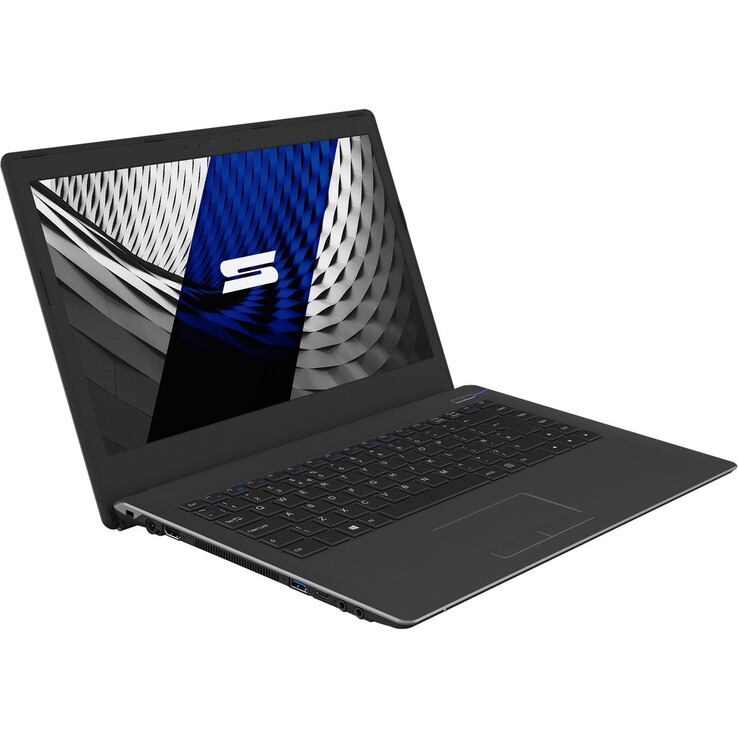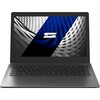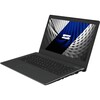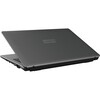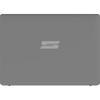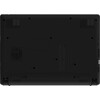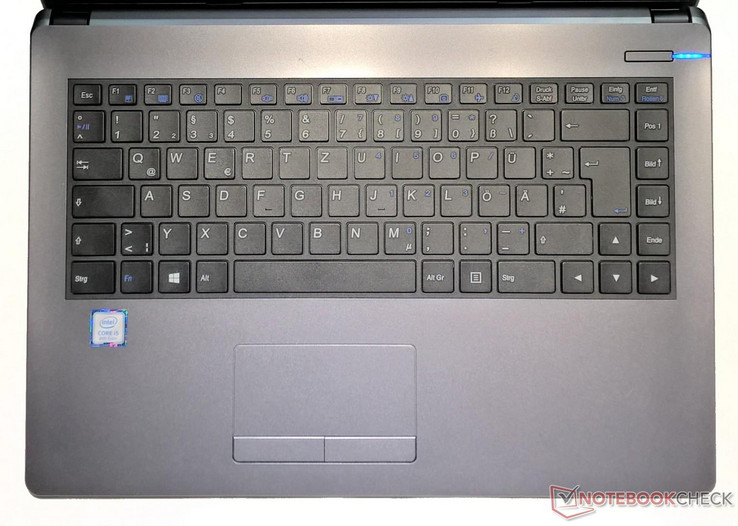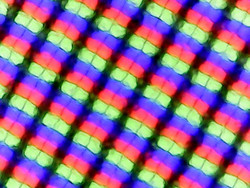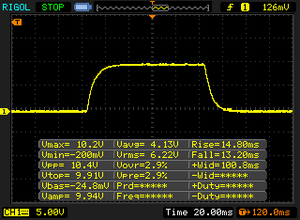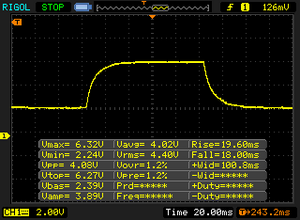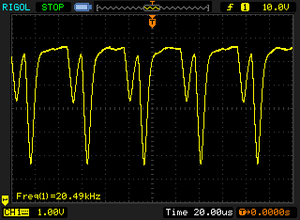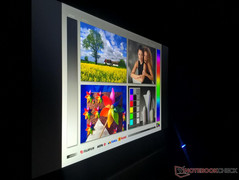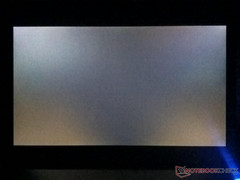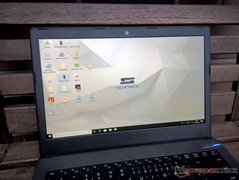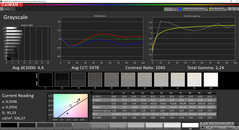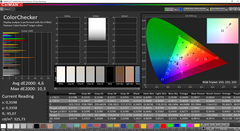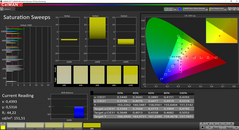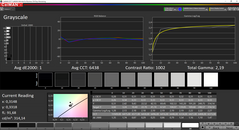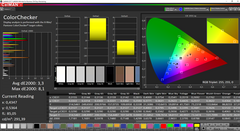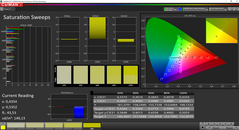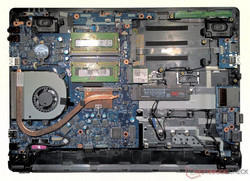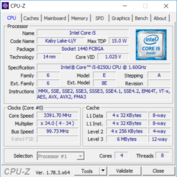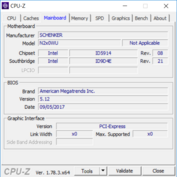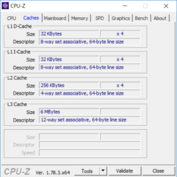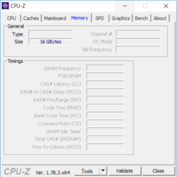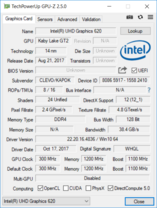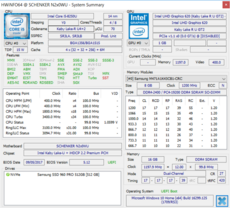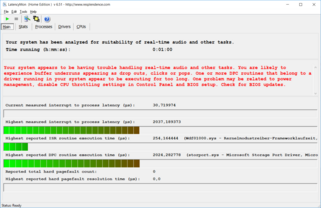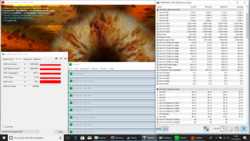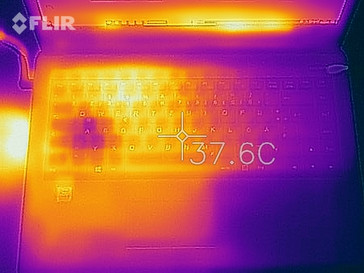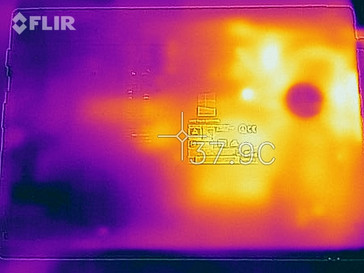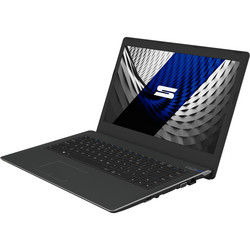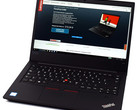Schenker Slim 14 (Clevo N240WU, i5-8250U, UHD 620) Laptop Review

Schenker regularly expands and replaces the notebooks in its own extensive product offerings. The Slim series was designed for users who are looking for a light and mobile device. With the display sizes ranging from 13 to 17-inches, there is something for everyone's preferences. Our test unit, the Slim 14, has a 14-inch display and is supposed to attract business users and students. The available configuration options, which you can freely choose from, allow for a price range starting from 680 Euros (~$816) and up to 2600 Euros (~$3120). At about 1200 Euros (~$1440), our test unit is slightly more expensive than the version recommended by the manufacturer.
For this price, buyers receive a 14-inch notebook with Intel's Core i5-8250 CPU, Intel UHD Graphics 620 as an integrated graphics solution, 16 GB of working memory, and a Samsung SSD 960 Pro with 512 GB of storage space. We chose comparison devices equipped with similar hardware for our test. Among them is the Acer Swift 3 SF314-52G which also measures 14-inches. With its Intel Core i7-8550U CPU, it also represents the alternative processor option for our test unit. The ThinkPad L470 from Lenovo, the Inspiron 13 7370 from Dell, and Acer's TravelMate P449-G2-M represent devices with similar CPU and GPU equipment.
Case and Features
The Slim 14 is equipped with a plastic case. The tops of the lid and base have a smooth, grey design, whereas the display bezel and the bottom of the base are made of simple, black plastic. The materials do not give a rugged impression and easily flex when under pressure. In particular, the display can be twisted too easily. However, this should not have any impact during everyday usage.
The battery can be taken out and replaced without any tools even when the notebook is running. Underneath the battery are some screws, which can be removed together with the remaining screws on the bottom of the Slim 14. After doing that, you can completely remove the bottom plate, gaining access to all of the hardware. You can clearly see the empty hard-drive slot in our test unit. The working memory can be replaced, the SSD can be exchanged without any problems, and the fan can be easily cleaned.
In addition to the usual connections, the Slim 14 also offers modern connections such as a USB-3.1 Gen 2 connection. The connection equipment should be sufficient for most everyday users. However, the notebook does not offer any particular equipment usual of a business notebook such as a smart-card reader. All the connections are well-positioned, so that there will not be any cable mess on the desk.
Connections
Card Reader and WLAN
The integrated card reader transfers data from storage cards at an average speed. The WLAN transfer rate is considerably faster. While it is still not sufficient for a top position, the Slim 14 is able to solidly make use of the fast ac standard. However, you can only get the Intel 8265 Tri-Band Wi-Fi adapter in our test unit for an additional 15 Euros (~$18). The Intel Wireless AC-3168 WLAN is the standard in the notebook at no additional cost.
| SD Card Reader | |
| average JPG Copy Test (av. of 3 runs) | |
| Schenker Slim 14 L17 (Toshiba Exceria Pro SDXC 64 GB UHS-II) | |
| Lenovo ThinkPad L470-20J5S00C00 (Toshiba Exceria Pro SDXC 64 GB UHS-II) | |
| Dell Inspiron 13 7370 (Toshiba Exceria Pro SDXC 64 GB UHS-II) | |
| Acer TravelMate P449-G2-M-56CD (Toshiba Exceria Pro SDXC 64 GB UHS-II) | |
| Acer Swift 3 SF314-52G-89SL (Toshiba Exceria Pro SDXC 64 GB UHS-II) | |
| maximum AS SSD Seq Read Test (1GB) | |
| Schenker Slim 14 L17 (Toshiba Exceria Pro SDXC 64 GB UHS-II) | |
| Lenovo ThinkPad L470-20J5S00C00 (Toshiba Exceria Pro SDXC 64 GB UHS-II) | |
| Dell Inspiron 13 7370 (Toshiba Exceria Pro SDXC 64 GB UHS-II) | |
| Acer TravelMate P449-G2-M-56CD (Toshiba Exceria Pro SDXC 64 GB UHS-II) | |
| Acer Swift 3 SF314-52G-89SL (Toshiba Exceria Pro SDXC 64 GB UHS-II) | |
Warranty and Accessories
Schenker includes a cleaning cloth and a USB stick with the Slim 14, which holds the system drivers and software for the notebook. The manufacturer offers a 24-month warranty on all its devices, including free pickup and return. The price also includes a six-month quick repair for free, and for an additional 60 Euros (~$72), the warranty can be expanded by a device check up, allowing you to send in the notebook for cleaning and maintenance during the warranty period. You can also expand the warranty and device check-up period up to 36 months for 160 Euros (~$192).
Input Devices
Schenker advertises the input devices of the Slim 14 with their "high long-term durability." At first glance, this impression also seems to fit. However after longer use, especially the Space key appears to be a weak point, since it only reacts reliably at one particular spot. If it is pressed down too far, inputs are not recognized. During our testing period, this was too often the case. The remaining keys sit tightly in their places and offer a comfortable and tight pressure point. Fast typing works smoothly and is only interrupted by the Space key. We also like the layout of the keys, and important Function keys are easily accessible.
A classical touchpad with dedicated mouse keys is used as the mouse replacement. The pad reacts reliably and multitouch input is also recognized precisely. While the right mouse key has a crisp pressure point and looks very robust, a very soft pressure is sufficient for the left mouse key, and it leaves the impression that it might quickly lose its stability.
Display
The display of the Schenker Slim 14 is an IPS panel with a resolution of 1920x1080 pixels. In the display evaluation, our test unit leaves most of the competing notebooks behind. In particular, the high brightness ensures an advantage. The contrast values and reaction times are also competitive. However, it becomes noticeable in our measurements that the brightness of the screen drops significantly from the top right corner to the bottom left corner. The brightness at the bottom area is about 75 cd/m² lower than at the top edge. Schenker does not offer any alternative displays for the Slim 14.
| |||||||||||||||||||||||||
Brightness Distribution: 81 %
Center on Battery: 326 cd/m²
Contrast: 1052:1 (Black: 0.31 cd/m²)
ΔE ColorChecker Calman: 4.6 | ∀{0.5-29.43 Ø4.77}
ΔE Greyscale Calman: 4.4 | ∀{0.09-98 Ø5}
85.1% sRGB (Argyll 1.6.3 3D)
55.8% AdobeRGB 1998 (Argyll 1.6.3 3D)
62.3% AdobeRGB 1998 (Argyll 3D)
85.2% sRGB (Argyll 3D)
66.1% Display P3 (Argyll 3D)
Gamma: 2.24
CCT: 5978 K
| Schenker Slim 14 L17 LG Philips LGD046D, , 1920x1080, 14" | Dell Inspiron 13 7370 BOE071A / NV13FHM / Dell G64PY, , 1920x1080, 13.3" | Acer Swift 3 SF314-52G-89SL AU Optronics B140HAN02.1, , 1920x1080, 14" | Lenovo ThinkPad L470-20J5S00C00 N140HCA-EAB, , 1920x1080, 14" | Acer TravelMate P449-G2-M-56CD N140HCA-EAB, , 1920x1080, 14" | |
|---|---|---|---|---|---|
| Display | 1% | -40% | -31% | -33% | |
| Display P3 Coverage (%) | 66.1 | 66.7 1% | 36.09 -45% | 42.21 -36% | 41.04 -38% |
| sRGB Coverage (%) | 85.2 | 86.2 1% | 54.2 -36% | 62.7 -26% | 61.2 -28% |
| AdobeRGB 1998 Coverage (%) | 62.3 | 63 1% | 37.28 -40% | 43.71 -30% | 42.47 -32% |
| Response Times | -20% | 1% | -22% | -2% | |
| Response Time Grey 50% / Grey 80% * (ms) | 37.6 ? | 46 ? -22% | 41 ? -9% | 50.4 ? -34% | 39 ? -4% |
| Response Time Black / White * (ms) | 28 ? | 33 ? -18% | 25 ? 11% | 30.8 ? -10% | 28 ? -0% |
| PWM Frequency (Hz) | 20490 ? | 201 ? | 25000 ? | ||
| Screen | -6% | -18% | -22% | -19% | |
| Brightness middle (cd/m²) | 326 | 301 -8% | 233 -29% | 274 -16% | 271 -17% |
| Brightness (cd/m²) | 320 | 291 -9% | 217 -32% | 256 -20% | 256 -20% |
| Brightness Distribution (%) | 81 | 87 7% | 88 9% | 85 5% | 85 5% |
| Black Level * (cd/m²) | 0.31 | 0.33 -6% | 0.27 13% | 0.35 -13% | 0.43 -39% |
| Contrast (:1) | 1052 | 912 -13% | 863 -18% | 783 -26% | 630 -40% |
| Colorchecker dE 2000 * | 4.6 | 5.39 -17% | 5.85 -27% | 6.1 -33% | 5.03 -9% |
| Colorchecker dE 2000 max. * | 10.3 | 8.56 17% | 11.51 -12% | 13.8 -34% | 11.9 -16% |
| Greyscale dE 2000 * | 4.4 | 5.93 -35% | 4.87 -11% | 5.7 -30% | 4.02 9% |
| Gamma | 2.24 98% | 2.6 85% | 2.47 89% | 2.11 104% | 2.31 95% |
| CCT | 5978 109% | 6358 102% | 6908 94% | 6419 101% | 6659 98% |
| Color Space (Percent of AdobeRGB 1998) (%) | 55.8 | 56 0% | 34 -39% | 40.2 -28% | 39 -30% |
| Color Space (Percent of sRGB) (%) | 85.1 | 86 1% | 54 -37% | 62.4 -27% | 61 -28% |
| Total Average (Program / Settings) | -8% /
-7% | -19% /
-20% | -25% /
-24% | -18% /
-19% |
* ... smaller is better
Display Response Times
| ↔ Response Time Black to White | ||
|---|---|---|
| 28 ms ... rise ↗ and fall ↘ combined | ↗ 14.8 ms rise | |
| ↘ 13.2 ms fall | ||
| The screen shows relatively slow response rates in our tests and may be too slow for gamers. In comparison, all tested devices range from 0.1 (minimum) to 240 (maximum) ms. » 70 % of all devices are better. This means that the measured response time is worse than the average of all tested devices (20.2 ms). | ||
| ↔ Response Time 50% Grey to 80% Grey | ||
| 37.6 ms ... rise ↗ and fall ↘ combined | ↗ 19.6 ms rise | |
| ↘ 18 ms fall | ||
| The screen shows slow response rates in our tests and will be unsatisfactory for gamers. In comparison, all tested devices range from 0.165 (minimum) to 636 (maximum) ms. » 53 % of all devices are better. This means that the measured response time is worse than the average of all tested devices (31.6 ms). | ||
Screen Flickering / PWM (Pulse-Width Modulation)
| Screen flickering / PWM detected | 20490 Hz | ≤ 99 % brightness setting | |
The display backlight flickers at 20490 Hz (worst case, e.g., utilizing PWM) Flickering detected at a brightness setting of 99 % and below. There should be no flickering or PWM above this brightness setting. The frequency of 20490 Hz is quite high, so most users sensitive to PWM should not notice any flickering. In comparison: 53 % of all tested devices do not use PWM to dim the display. If PWM was detected, an average of 8084 (minimum: 5 - maximum: 343500) Hz was measured. | |||
Subjectively, the display of the Slim 14 offers an agreeable image. Colors look good and the strong contrast ensures clean edges. However, black tones could have been slightly more saturated, and the display shows more of a dark gray rather than a saturated black. The reason for this becomes clear in our measurements. A slightly high black value and mediocre color-space coverage lead to this impression. However, these results hardly lead to any problems in everyday usage. The viewing angles of the built-in IPS panel are very stable, and the brightness is sufficient for work outdoors.
Performance
Our test unit is equipped with Intel's Core i5-8250U CPU and Intel's UHD Graphics 620. They are accompanied by 16 GB of dual-channel RAM and a fast Samsung SSD. With this, the Slim 14 is well-equipped for most office tasks. You can expand the working memory up to 32 GB for more performance. As an alternative processor, Intel's Core i7-8550U is also available. When configuring the Slim 14, you should keep in mind that the selected hard drive has a strong impact on the system performance. You can also choose slow HDDs with 5400 rpm which are significantly cheaper than SSDs, but also slow down the system considerably.
Processor
The Intel Core i5-8250U is a processor of the Kaby Lake refresh generation and offers four cores with clock speeds of 1.6 to 3.4 GHz. With a TDP of 15 watts, the CPU is very energy-efficient and at the same time offers more performance than the direct predecessor, the Core i5-7200U. How well the notebook can make use of the available performance depends a lot on its cooling system.
You can read on our CPU benchmark page how well the built-in Intel Core i5-8250U fares compared to other processors.
As our Cinebench endurance test shows, the Slim 14 can only offer the maximum performance at the beginning of the benchmark. After that, the performance drops, but it can be maintained evenly at that level for the remainder of the test. In our competing devices that have the same CPU, the performance drops even further. In this test, the Slim 14 shows itself as the steadiest device. Even though it only achieves mediocre values in the Cinebench single test, the performance can be maintained more evenly in the long run. The same goes for battery mode.
System Performance
The Slim 14 was designed as a notebook for office and business applications and confirms this concept with its results in the PCMark 8 benchmark. Our test unit places ahead of the similarly equipped competitors and is also able to surpass the Acer Swift 3 with the Core i7-8550U which should really be faster. That processor is also available as an option for the Slim 14, and Schenker asks for an additional surcharge of 102 Euros (~$122) for this. It might well be possible that the very fast Samsung SSD 960 Pro has provided the decisive speed advantage here.
| PCMark 8 - Home Score Accelerated v2 | |
| Schenker Slim 14 L17 | |
| Acer Swift 3 SF314-52G-89SL | |
| Dell Inspiron 13 7370 | |
| Acer TravelMate P449-G2-M-56CD | |
| Lenovo ThinkPad L470-20J5S00C00 | |
| PCMark 8 Home Score Accelerated v2 | 4006 points | |
Help | ||
Storage Solution
Schenker has equipped our test unit with a Samsung SSD 960 Pro, which can be inserted into the Slim 14 for an additional charge of 369 Euros (~$443). For this, buyers receive a very fast drive, which has a noticeable effect on the system speed. Since this storage drive is currently in sixth place in our SSD/HDD benchmark list, it is not surprising that the Slim 14 surpasses the competitors in this area.
A Seagate Barracuda with 500 GB of storage space is built into the basic configuration of the Schenker Slim 14 at no surcharge. However, the manufacturer recommends a Samsung 850 Evo with 250 GB in combination with a large 1 TB Seagate Barracuda.
| Schenker Slim 14 L17 Samsung SSD 960 Pro 512 GB m.2 | Dell Inspiron 13 7370 Micron 1100 MTFDDAV256TBN | Acer Swift 3 SF314-52G-89SL Intel SSD 600p SSDPEKKW512G7 | Lenovo ThinkPad L470-20J5S00C00 SanDisk X400 256GB, SATA (SD8SB8U-256G) | Acer TravelMate P449-G2-M-56CD Intel SSD 600p SSDPEKKW512G7 | |
|---|---|---|---|---|---|
| CrystalDiskMark 3.0 | -70% | -44% | -63% | -38% | |
| Read Seq (MB/s) | 2860 | 476.8 -83% | 944 -67% | 495.2 -83% | 1086 -62% |
| Write Seq (MB/s) | 1995 | 458.3 -77% | 552 -72% | 485.7 -76% | 581 -71% |
| Read 512 (MB/s) | 815 | 351 -57% | 616 -24% | 323.4 -60% | 869 7% |
| Write 512 (MB/s) | 1480 | 298.2 -80% | 483.3 -67% | 291.5 -80% | 584 -61% |
| Read 4k (MB/s) | 57.7 | 20.79 -64% | 13.98 -76% | 34.2 -41% | 35.89 -38% |
| Write 4k (MB/s) | 196.7 | 65.8 -67% | 133.6 -32% | 74.3 -62% | 122.4 -38% |
| Read 4k QD32 (MB/s) | 565 | 172.8 -69% | 462.6 -18% | 321.3 -43% | 462.9 -18% |
| Write 4k QD32 (MB/s) | 475.1 | 160.3 -66% | 496.2 4% | 188 -60% | 370.9 -22% |
Graphics Card
In our test unit, an Intel UHD Graphics 620 provides for the display of the screen content. This integrated graphics solution is sufficient for most office applications and can even almost measure up to a GeForce 920M by Nvidia or a Radeon R7 M440 by AMD for graphically demanding applications. In the 3DMark-11 benchmarks, the Slim 14 achieves average values which correspond to the average of all the devices we tested. Schenker does not offer an alternative graphics card.
You can read up on the results of other notebooks that have the Intel UHD Graphics 620 on our GPU benchmark page.
| 3DMark 11 - 1280x720 Performance GPU | |
| Acer Swift 3 SF314-52G-89SL | |
| Dell Inspiron 13 7370 | |
| Schenker Slim 14 L17 | |
| Lenovo ThinkPad L470-20J5S00C00 | |
| Acer TravelMate P449-G2-M-56CD | |
| 3DMark 11 Performance | 1883 points | |
Help | ||
Gaming Performance
The graphics solution of the Slim 14 is quite suited for older games and casual gaming. However, most modern games run smoothly only in lower settings or cannot even be started. BioShock Infinite from 2013, which we tested, could only be displayed smoothly in medium settings. Anyone who can also tolerate the occasional stutter might also be satisfied with the "High" graphics level. In any case, you should use dual-channel RAM, otherwise the performance will be much worse.
You can find out about the performance which Intel's UHD Graphics 620 permits in other games in our GPU games list.
| low | med. | high | ultra | |
|---|---|---|---|---|
| BioShock Infinite (2013) | 65.5 | 34.46 | 29.54 | 10.15 |
Emissions and Power
Noise Emissions
In everyday operation, the Slim 14 is only audible in very quiet surroundings. The fan also runs during low system loads and produces an even whir. Under load, the volume rises only slightly. So while you have to tolerate a continuous fan noise when using the device, the noise is not very loud and is easily drowned by the surrounding noises.
Noise level
| Idle |
| 28.7 / 29.5 / 29.5 dB(A) |
| Load |
| 30.5 / 33.4 dB(A) |
 | ||
30 dB silent 40 dB(A) audible 50 dB(A) loud |
||
min: | ||
Temperature
While idling, the Slim 14 does not warm noticeably. However, under load the surface temperatures quickly rise above 40 °C (104 °F), and in particular the left side of the base warms up a lot. The higher temperatures can be clearly noticed on the left palm rest. The same goes for running the device on your lap. However, the notebook never felt too hot.
Our stress test caused the CPU temperature of the Slim 14 to rise up to 70 °C (158 °F). In the hour-long test, the clock speeds dropped to below 1.3 GHz, which is below the basic clock speed. A subsequent 3DMark11 benchmark produced a result which was only about 100 points lower. Since such an extreme load almost never occurs during everyday operation, there should not be any limitations for users due to throttling.
(±) The maximum temperature on the upper side is 41.9 °C / 107 F, compared to the average of 34.3 °C / 94 F, ranging from 21.2 to 62.5 °C for the class Office.
(±) The bottom heats up to a maximum of 43.7 °C / 111 F, compared to the average of 36.8 °C / 98 F
(+) In idle usage, the average temperature for the upper side is 24.1 °C / 75 F, compared to the device average of 29.5 °C / 85 F.
(+) The palmrests and touchpad are reaching skin temperature as a maximum (34 °C / 93.2 F) and are therefore not hot.
(-) The average temperature of the palmrest area of similar devices was 27.6 °C / 81.7 F (-6.4 °C / -11.5 F).
Speakers
The speakers of the Slim 14 are positioned at the bottom of the base. When the notebook is placed on a table, the low overall volume is sufficient to hear the sounds. However, if you place the device on your lap, the audio signals are muffled and are only audible in quiet surroundings. Added to this is the fact that the speakers have practically no bass and the high frequencies also drop off slightly. To enjoy media content, you should preferably use headphones or external speakers.
Schenker Slim 14 L17 audio analysis
(±) | speaker loudness is average but good (75.5 dB)
Bass 100 - 315 Hz
(-) | nearly no bass - on average 25.8% lower than median
(±) | linearity of bass is average (8.6% delta to prev. frequency)
Mids 400 - 2000 Hz
(±) | higher mids - on average 7.1% higher than median
(±) | linearity of mids is average (9.4% delta to prev. frequency)
Highs 2 - 16 kHz
(±) | higher highs - on average 7.6% higher than median
(±) | linearity of highs is average (8.4% delta to prev. frequency)
Overall 100 - 16.000 Hz
(-) | overall sound is not linear (33.5% difference to median)
Compared to same class
» 95% of all tested devices in this class were better, 2% similar, 3% worse
» The best had a delta of 7%, average was 21%, worst was 53%
Compared to all devices tested
» 92% of all tested devices were better, 1% similar, 7% worse
» The best had a delta of 4%, average was 24%, worst was 134%
Dell Inspiron 13 7370 audio analysis
(-) | not very loud speakers (70 dB)
Bass 100 - 315 Hz
(-) | nearly no bass - on average 19.5% lower than median
(±) | linearity of bass is average (10.2% delta to prev. frequency)
Mids 400 - 2000 Hz
(±) | higher mids - on average 6.7% higher than median
(±) | linearity of mids is average (12.5% delta to prev. frequency)
Highs 2 - 16 kHz
(+) | balanced highs - only 3.2% away from median
(±) | linearity of highs is average (8.9% delta to prev. frequency)
Overall 100 - 16.000 Hz
(±) | linearity of overall sound is average (26% difference to median)
Compared to same class
» 78% of all tested devices in this class were better, 7% similar, 14% worse
» The best had a delta of 7%, average was 21%, worst was 53%
Compared to all devices tested
» 79% of all tested devices were better, 4% similar, 16% worse
» The best had a delta of 4%, average was 24%, worst was 134%
Frequency comparison (checkboxes selectable!)
Power Consumption
The power consumption of the Slim 14 corresponds to the consumption of comparable devices. While our test unit is energy-efficient with this, it uses up to 41 watts for short periods of time under load. This exceeds the power of the included 40-watt power supply. However, afterwards the measurement levels out quickly at around 40 watts. So while the power supply is tightly dimensioned, it should be sufficient to provide more than enough power to the Slim 14.
| Off / Standby | |
| Idle | |
| Load |
|
Key:
min: | |
Battery Life
Our test unit achieved a mediocre runtime in our practically relevant WLAN test. After 5 hours, the battery was empty. Most of the competing devices lasted a bit longer. While compared to the competition, the Slim 14 has the advantage that the battery can be exchanged easily, Schenker does not offer a replacement battery for the Slim 14 on its website yet.
| Battery Runtime - WiFi Websurfing | |
| Lenovo ThinkPad L470-20J5S00C00 | |
| Acer Swift 3 SF314-52G-89SL | |
| Dell Inspiron 13 7370 | |
| Acer TravelMate P449-G2-M-56CD | |
| Schenker Slim 14 L17 | |
Pros
Cons
Verdict
The Schenker Slim 14 is a solid business and office notebook, which can be maintained easily. Its low weight makes the device very mobile, but the mediocre battery life does not allow for a full workday without a charger. When configuring the device, you should carefully choose the combination of components, since we expect a lower system performance in the basic configuration.
With the Slim 14, Schenker offers a light and mobile device. If it does not have to be very quiet and there is usually an outlet nearby, then the Slim 14 can be a good everyday companion for work and studies.
With the Slim 14, Schenker mainly wants to attract business users and students. Our test unit can be recommended for all users who are looking for a light and mobile device. However, due to the clearly audible typing noises and the frequently active fan, the Slim 14 is not suited for work in very quiet surroundings. Simple maintenance options and solid connection equipment are sufficient for most application areas.
Schenker Slim 14 L17
- 01/02/2018 v6 (old)
Mike Wobker




